If you’ve decided to take the Portuguese Way (Camino Portugues) to reach Santiago de Compostela, the most visited sacred Christian site in Europe, we know that there is a lot of planning involved. Maybe you’re also here to understand if you’re ready to embark on this spiritual journey.
Either way, we’re here to help! We’ve gathered everything you need to know about the Camino Portugues, so let’s get started!
Santiago Ways – The Camino Portugues
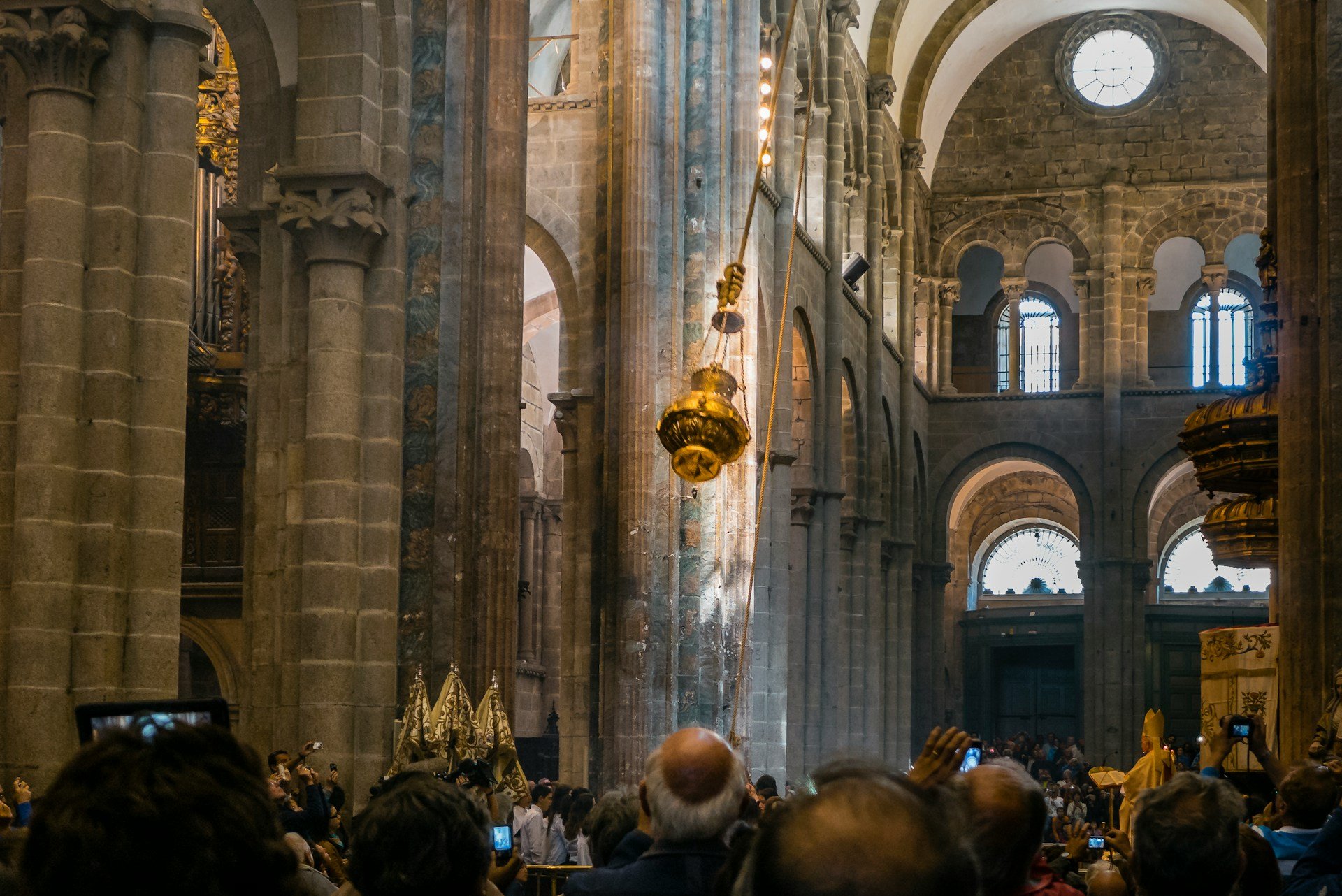
If you’re reading this article, you probably already know a lot about the Santiago Ways – a network of pilgrimages that start in different points across Europe and end at the cathedral of Santiago de Compostela in Galicia.
The remains of James the Great, one of the Twelve Apostles of Jesus and the patron saint of Spain, are buried at the cathedral. As such, pilgrims take these routes to reach the remains of Santiago as a way to cleanse themselves and grow spiritually. In fact, these routes have been the most important Christian pilgrimages ever since the Middle Ages.
There are several Santiago Ways, the Camino Portugues being the second most popular. It has two starting points: the cathedral in Lisbon or the cathedral in Porto.
Statistics show that the Camino Portugues has registered almost 53,000 pilgrims over 10 months, which represents nearly 20% of the total number of pilgrims that reached Santiago de Compostela within that period, confirming that this route is preferred by many.
Furthermore, many pilgrims are particularly interested in the Camino Portugues – Coastal Route, which, over that same period, served as a pathway to Galicia for almost 6,500 pilgrims, accounting for 4.41%. This makes the coastal Portuguese Camino the 7th most popular Santiago Way!
Camino Portugues – General Details
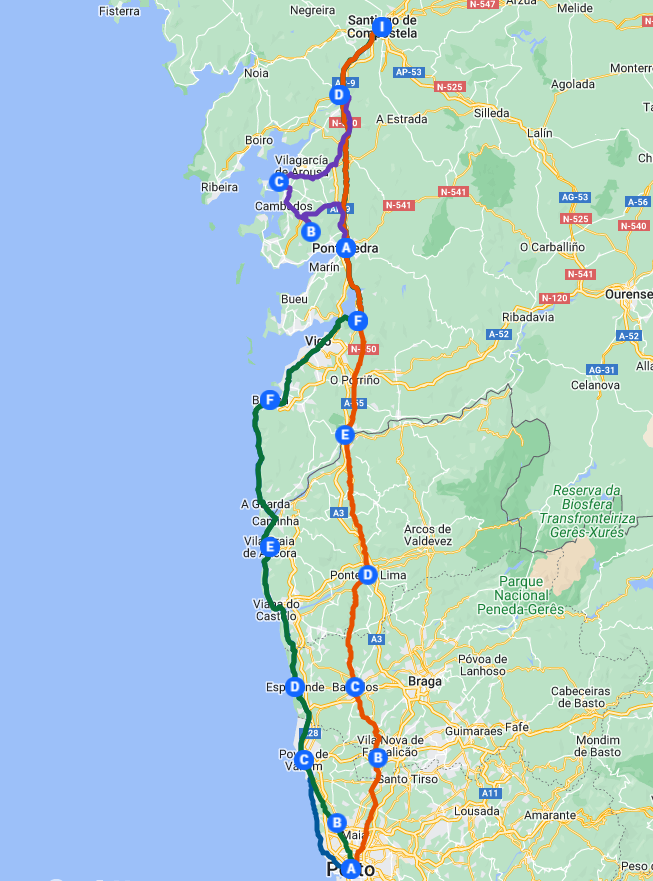
Blue Line – the Litoral Way
Green Line – the Coastal Route
Red Line – the Central Route
Purple Line – the Spiritual Variant
Here are some general details about the Camino Portugues:
- Lisbon to Santiago de Compostela: 379 miles (610 km)
- Starting point: Sé Cathedral in Lisbon
- Duration: 25 – 30 days
- End point: Obradoiro Square in Santiago de Compostela
- Porto to Santiago de Compostela (Camino Portugues Central Route): 162 miles (260 km)
- Porto to Santiago de Compostela (Camino Portugues Coastal Route): 174 miles (280 km)
- Starting point: Se Cathedral in Porto
- Duration: 12 – 15 days
- End point: Obradoiro Square in Santiago de Compostela
- Tui to Santiago de Compostela: 73 miles (118 km)
- Starting point: the Cathedral of Santa Maria de Tui
- Duration: 5 – 7 days
- End point: Obradoiro Square in Santiago de Compostela
Camino Portugues – from Lisbon to Porto
The Camino Portugues from Lisbon to Porto is, obviously, the longest. Nonetheless, it goes without saying that it takes you through the most uplifting spiritual and cultural path. And we’re here to guide you through it.
If you’re thinking of taking the long Camino Portugues, there’s an important thing you should know – the road from Lisbon to Porto is slightly off the beaten track. In other words, you won’t pass any very touristy places. However, this is actually what makes this route incredibly authentic. You’ll see the raw Portugal.
One thing that makes this route slightly difficult is the lack of infrastructure for pilgrims, which is understandable, considering that few pilgrims actually take this route. This means that your pilgrimage may be more expensive because the albergues (hotels for pilgrims) are often 31 miles (50 km) apart, so you may have to book a room in a hotel.
Other than that, the Camino Portugues from Lisbon is a marvel to behold! It’s not a leisurely walk, but it’s also not a crazy high-altitude hike far off the beaten path. Obviously, you’ll get tired, considering that you’ll also have your backpack, but it’s always better to walk on straight roads rather than hills.
Lisbon to Porto – Camino Portugues Route
Now, you’re probably wondering if beginning your Portuguese Way to Santiago de Compostela from Lisbon is worth it. We’ll share the route to help you decide. Keep reading to learn more about the stops along the Portuguese Camino.
The Portuguese Camino – From Lisbon to Golegã
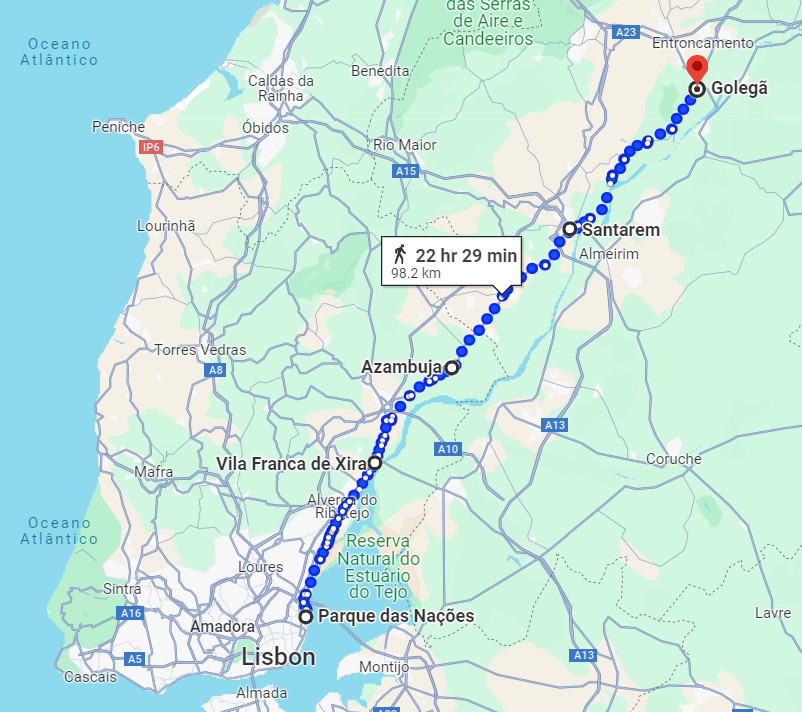
- In Lisbon, you’ll head to the Parque das Nações and then to the countryside, although some people prefer to take the train to the next stop, which is…
- Vila Franca de Xira, a beautiful town known for its bullfighting festival.
- There is no private or municipal albergue, so you’ll have to book a hotel room.
- Vila Franca de Xira -> Azambuja = 12 miles (19 km)
- You’ll still follow the Tejo River while walking to Azambuja, a pretty town known for its bull run.
- There’s a municipal albergue in Azambuja where you can stay the night; it’s called Albergue Abrigo Do Peregrino.
- Azambuja -> Santarém = 17 miles (27 km)
- This route is filled with gems, vineyards, crop fields, orchards, etc.; Santarem is the highest point of the route (110 meters high); it’s an incredibly beautiful Moorish city with narrow streets that will feel like a time-machine!
- It’s worth noting that approximately 6.2 miles (10 km) of this Camino Portugues is through open fields, so make sure you have enough water and can protect yourself from the sun.
- There’s a municipal albergue in Santarem; it’s called Albergue N1 Hostel, and you can book the room online.
- Santarem -> Golegã = 19 miles (32 km)
- As you head northwest to Golegã, you’ll see authentic villages and dozens of horses and bulls!
- You can stay at an albergue in Golegã.
- If this route is too long, you can split it in half and stop somewhere in between, depending on the route you’ll take. For example, you can stop in São Vicente do Paul or Azinhaga, where you can stay at Albergue de Peregrinos de Azinhaga.
The Portuguese Camino – from Golegã to Coimbra
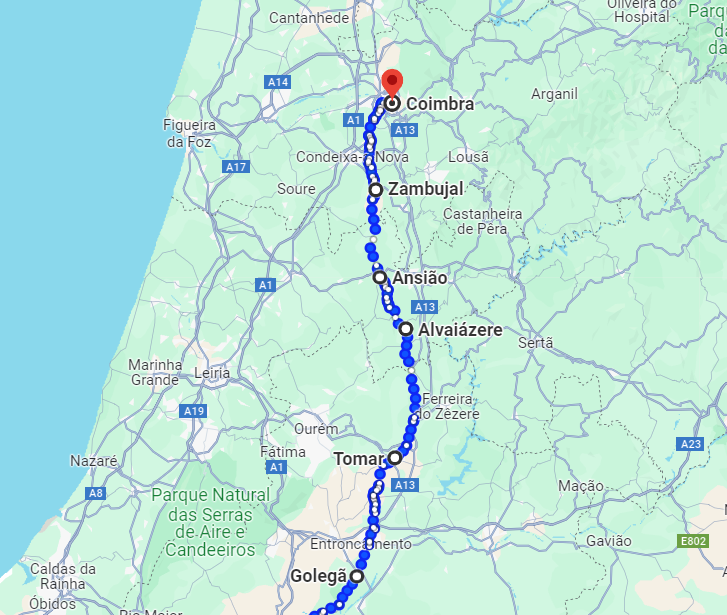
- Golega -> Tomar = 17.4 miles (28 km)
- On your way to Tomar, make sure to stop by the famous manor house Quinta da Cardiga. Then, yet again, you’ll pass through several small villages until you reach Tomar.
- There are two municipal albergues in Tomar.
- Tomar -> Alvaiázere = 18 miles (29 km)
- The way from Tomar to Alvaiázere is as peaceful as it can get! It’s filled with woodlands, valleys, and ancient Roman roads. A true delight!
- Alvaiázere does have an albergue, so make sure to check if there are any available rooms.
- Alvaiazere -> Ansião = 8.6 miles (14 km)
- As you’ve noticed, this part of Camino Portugues is shorter than others, mainly because it’s governed by hills.
- There are no albergues in Ansião, so you’ll have to book a room.
- Ansião -> Zambujal = 12.4 miles (20 km)
- You can stay at a private albergue in Zambujal called Albergue Casa Das Raposas, which can accommodate 18 people.
- Zambujal -> Coimbra = 14 miles (23 km)
- And here we are, headed to Coimbra, one of Portugal’s most charming cities! On your way there, you’ll walk through some pretty villages, where you’ll see well-preserved old houses and a 16th-century bridge.
- Coimbra has both municipal and private albergues.
The Portuguese Camino – From Coimbra to Porto
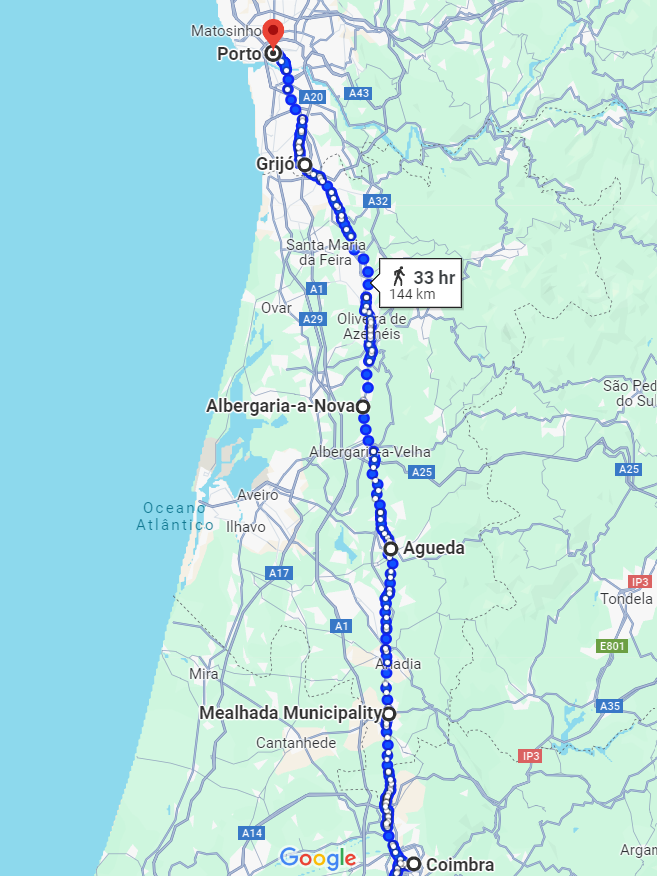
- Coimbra -> Mealhada = 14 miles (23 km)
- The walk to Mealhada is quite pleasant and easy, except for the hill to Santa Luzia.
- Mealhada has a private albergue called Hilario, which costs between 10 and 15 EUR.
- Mealhada -> Agueda = 14 miles (23 km)
- From Mealhada, the Camino Portugues takes you to Agueda through a beautiful trail filled with vineyards, forests, and small cities.
- Agueda has a private albergue called Albergue Santo Antonio.
- Agueda -> Albergaria A Nova = 13.6 miles (22 km)
- On your way to Albergaria A Nova, you’ll walk on a road known as Via Romana XVI, an ancient Roman road with plenty of eucalyptus and pine trees.
- This road is a bit difficult because it has two uphill walks. Apart from this, it’s a delight!
- Albergaria A Nova has a private albergue, which can accommodate 12 people.
- Albergaria A Nova -> São João da Madeira = 13 miles (21 km)
- Today’s trip is a bit longer, but it’s totally worth it nonetheless! It will take you through both woodlands and cities. More precisely, you can stop in Oliveira de Azeméis, where you can check out the Matriz de São Miguel church, and the beautiful town of Arrifana. From there, you’ll walk along an ancient Roman road that will take you to São João da Madeira.
- São João da Madeira has both municipal and private albergues.
- São João da Madeira -> Grijó = 12.4 miles (20 km)
- You’ll soon be in Porto, so this short 21-km-long walk should leave you excited, especially since there are a lot of cafes and shops on the road! You can stop for a coffee or lunch, then continue your walk to the charming city of Porto.
- Grijó has a municipal albergue called Albergue São Salvador de Grijó.
- Grijó -> Porto = 11 miles (18 km)
- And here we are, arriving in Porto! If you want to explore the city, it’s best to start early from Grijó. Or, if you want to take a longer break, why not book a hotel room for two or three nights?! There’s undoubtedly plenty to see in the city before embarking on the second part of your Camino Portugues.
Tips for Your Camino Portuguese to Porto
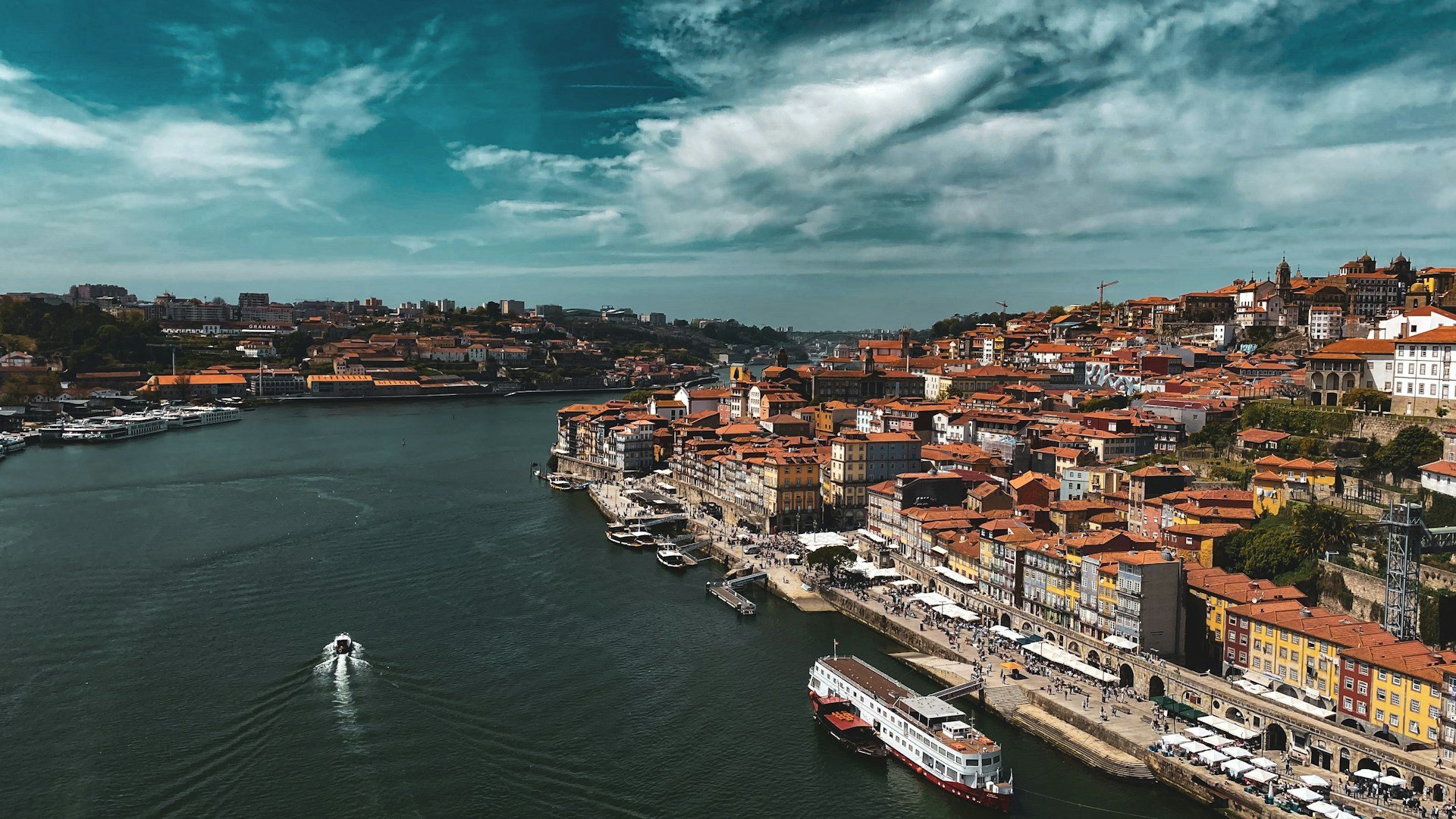
We’ve prepared some tips for your Camino Portugues from Lisbon to Porto:
- Make sure to have enough cash, as you may not find too many ATMs, especially in small towns or villages.
- If possible, book your stay at the albergues beforehand, especially if you’re walking the Camino Portugues during the peak season.
- Whenever you stumble upon a cafe, stop to refill your bottle because there may be no cafes over the next few miles.
- If you have any health conditions you may need medication for, we recommend buying them in advance. Some cities have pharmacies, others don’t. In addition, pack some essentials just in case you need them – some painkillers, for example.
- If you don’t mind prolonging your trip, you can merge your Camino Portugues with Camino de Fatima. Instead of heading to Tomar from Santarem, you’ll walk to Fatima and then to Ansiao. This way, you’ll visit the Sanctuary of Our Lady of Fatima, one of Europe’s most important Christian sites.
- It’s best to have travel insurance for this walking trip.
- May and June are the best months to begin your journey. It still rains occasionally in April, while July and August are too hot. You can also walk the Portuguese Way from Lisbon to Porto in September.
- You’ll probably need approximately 25 – 30 EUR per person daily for food and accommodation.
- Don’t pack too many things. There aren’t too many luggage transportation services from Lisbon to Porto.
The Camino Portugues – Coastal Route, from Porto to Santiago de Compostela
Now that we’ve arrived in Porto, it’s time to decide how we’ll reach Santiago de Compostela – through the Camino Portugues Coastal Route or the Camino Portugues Central Route.
As already mentioned, most pilgrims choose Porto as the starting point of their pilgrimage because the camino is more populated, there are more albergues on the route, and there are more luggage transportation services. And, of course, the obvious reason – the pilgrimage duration is cut in half because it only takes you approximately 15 days to reach Santiago de Compostela from Porto, regardless of what route you pick.
To help you pick the best route for you, we’ve included details about both. Let’s start with the coastal route, which seems to have gained much popularity in recent years.
The Portuguese Camino – the Coastal Route Stops
It will take you approximately 12 – 15 days to get from Porto to Santiago de Compostela through the coastal route of the Camino Portugues.
Before we begin our journey, we must mention that the coastal route doesn’t take you directly to the coast, meaning you won’t always walk through coastal cities.
If you want to walk closer to the shore, you’ll have to take the Litoral Way when leaving Porto, but it implies a longer detour. However, the Litoral Way and the Coastal Route merge at Vila do Conde (see below both routes for comparison).
- Porto -> Vila Chã = 13 miles (21 km)
- If you want to take the Litoral Way, you’ll go through Matosinhos, Lavra, and Labruge to reach Vila Chã. It’s a pleasant trip with plenty of cafes. However, it’s worth noting that the first 10 km of this route isn’t marked.
- If you want to take the Coastal Route, you’ll go through Padrão de Légua, Vila Nova de Telha, and Labruge to reach Vila Chã.
- Vila Chã has a municipal albergue called Municipal Albergue de S. Mamede.
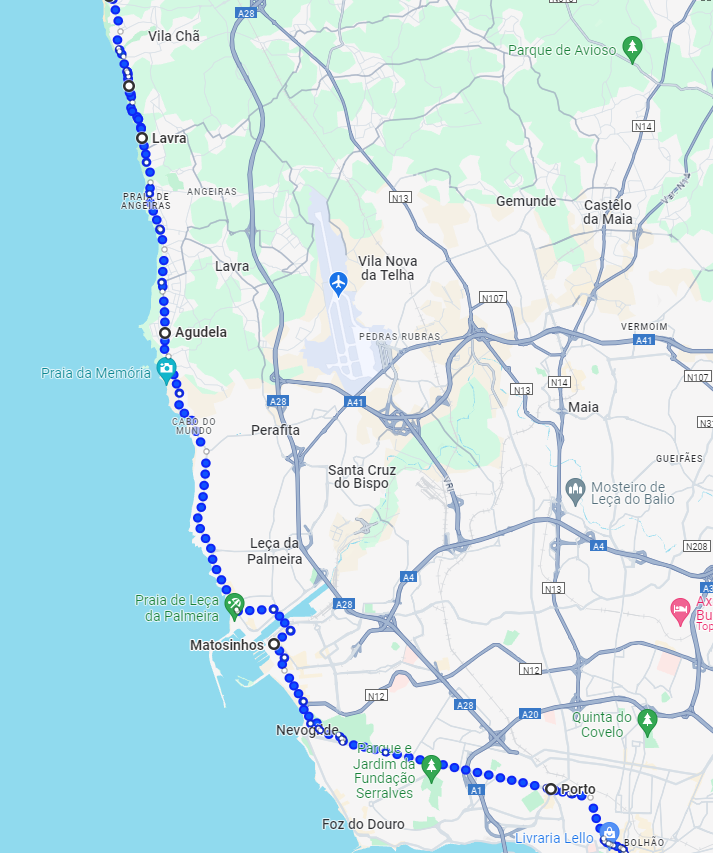
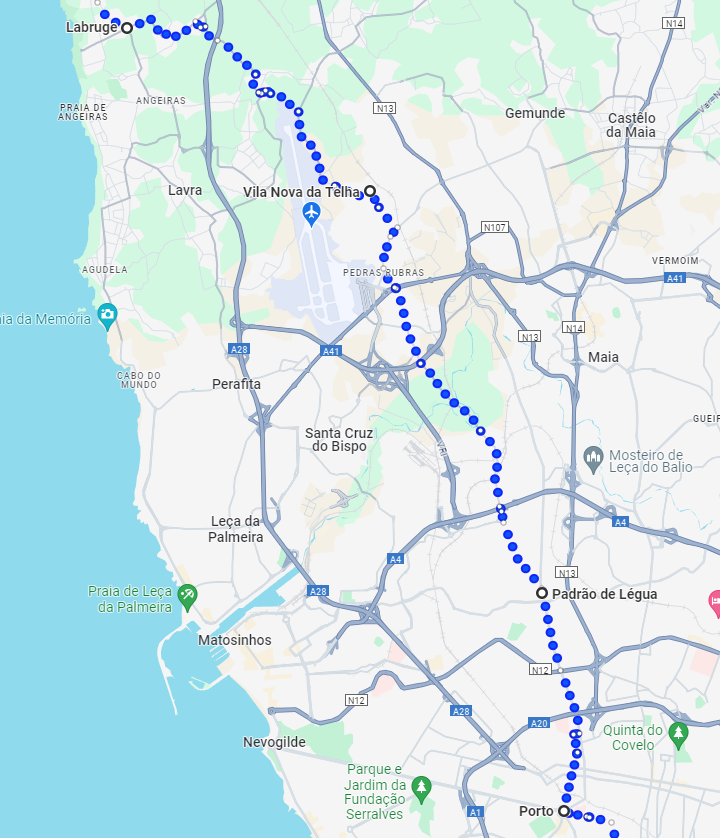
- Vila Chã -> Póvoa de Varzim = 9.3 miles (15 km)
- On your way to Póvoa de Varzim, you’ll have a nice walk parallel to the coast with plenty of cafes to stop by. At one point, you’ll switch to a rather inland route, passing through Vila do Conde.
- Póvoa de Varzim -> Esposende = 12 miles (19 km)
- From Póvoa de Varzim, head toward Praia Estela, Praia Apúlia, and Praia Fão to reach Esposende.
- Esposende -> Viana do Castelo = 13.7 miles (22 km)
- The walk from Esposende to Viana do Castelo is a bit tiring because of the hills, but the scenery is undoubtedly worth it, as well as the historical center of our destination!
- Once in Viana do Castelo, you can stay at the Albergue de Santa Luzia.
- Viana do Castelo -> Vila Praia de Âncora = 15 miles (24 km)
- Some pilgrims prefer walking past Vila Praia de Âncora, but we recommend stopping here for the night if you feel tired or aren’t experienced with such long walks.
- The road from Viana do Castelo to Vila Praia de Âncora is quite pleasant, taking you through various places along the Atlantic coast while heading North.
- Vila Praia de Âncora -> A Guarda = 8.6 miles (14 km)
- And here we are, crossing the border to Spain! Today’s trip is quite beautiful with nice views and historical and authentic villages.
- On your way to A Guarda, you’ll have to cross the Minho River by boat.
- Once you’re in Spain you can, yet again, pick one of the two routes – the Litoral Way or the official Coastal Route. The Litoral Way is a bit longer but definitely worth it thanks to the stunning views and the pleasant breeze. The Coastal route takes you from A Guarda North through an inland route.
The Portuguese Camino through Spain
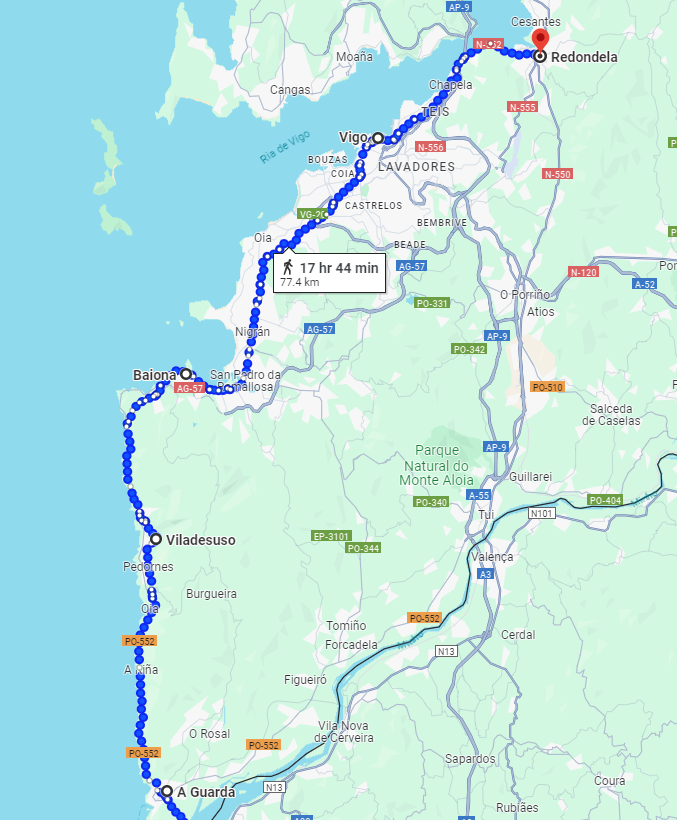
Let’s continue our Camino Portugues through Spain:
- A Guarda -> Viladesuso = 11 miles (18 km)
- Yet another walk along the Atlantic coast with plenty of nature to enjoy and sunshine to bathe in.
- You can also take the inland route, which takes you through several villages and forests. However, it’s worth noting that this part doesn’t have too many shops or cafes, especially if you take the Litoral Way.
- Viladesuso -> Baiona = 8.6 miles (14 km)
- From Viladesuso, you can again pick a route – either along the shore or the official Coastal Route, which is a bit farther away from the Atlantic coast. There’s no big difference between them in terms of distance.
- Once you reach Baiona, you can stay at one of the several albergues in the town.
- Baiona -> Vigo = 13.7 miles (22 km)
- Once again, you can pick the Litoral Way or the Coastal Route or combine the two. It’s worth noting that the Coastal Route takes you through industrial areas, and it’s slightly longer, so you may have to choose the Litoral Way if you prefer quiet walks and peaceful views.
- In Vigo, you can stay at the Public Albergue de Vigo.
- Vigo -> Redondela = 8.6 miles (14 km)
- This short walking trip is filled with breathtaking views. However, it has a disadvantage – there are few restaurants and shops along the way. But it’s not a long or tiring walk, so we’re sure you’ll reach your destination safely!
- In Redondela, you can stay at the Public Albergue de Redondela.
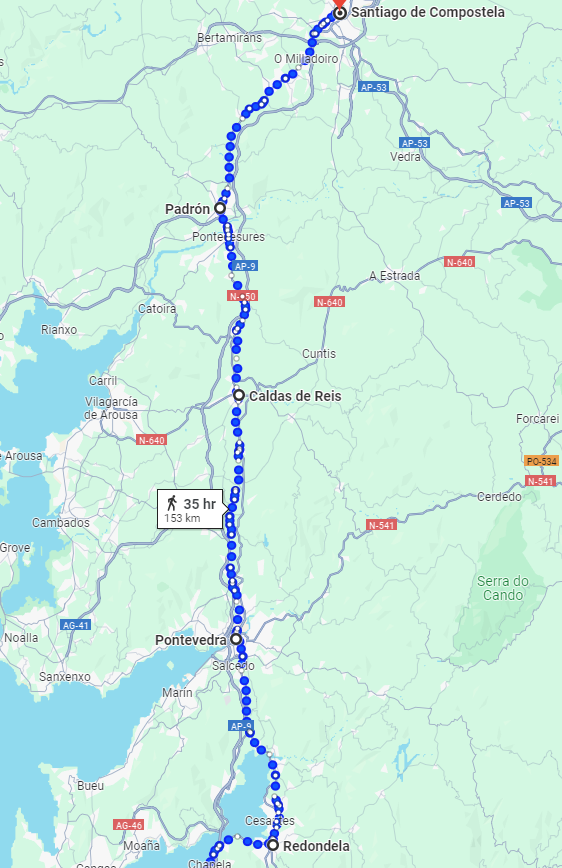
- Redondela -> Pontevedra = 12 miles (19 km)
- The route from Redondela to Pontevedra will mainly take you through forests, but there are still plenty of coffee shops along the way.
- In Pontevedra, you can stay at the Public Albergue Virgen Peregrina or the Albergue Nacama Hostel Pontevedra.
- Pontevedra -> Caldas de Reis = 14 miles (23 km)
- Make sure to have breakfast before you begin today’s trip, or pack some snacks. The only cafes and restaurants are 6.2 miles (10 km) from Pontevedra.
- Once in Caldas de Reis, you can stop at Albergue A Queimada or Albergue Agarimo.
- Caldas de Reis -> Padrón = 10.5 miles (17 km)
- On your way to Padrón, you’ll pass through peaceful forests with several cafes. When you reach Padrón, you can go for a walk along the Padrón promenade – it’s a true delight!
- In Padrón, you can stay at Albergue Corredoiras, Hostel & Rooms O Albergue da Meiga, or at the public albergue.
- Padron – Santiago de Compostela = 14 miles (23 km) (or split the distance between two days)
- And here we are – on the last part of our Camino Portugues! The distance is indeed a bit longer today, and the walk is slightly difficult because the second half has many ascents and descents. However, if you think it’s too much for you, you can split this trip into two days – there’s no rush anyway!
- In Santiago de Compostela, you can stay at Albergue Seminario Menor or Santiago KM-0.
Tips for Your Camino Portugues Coastal Route
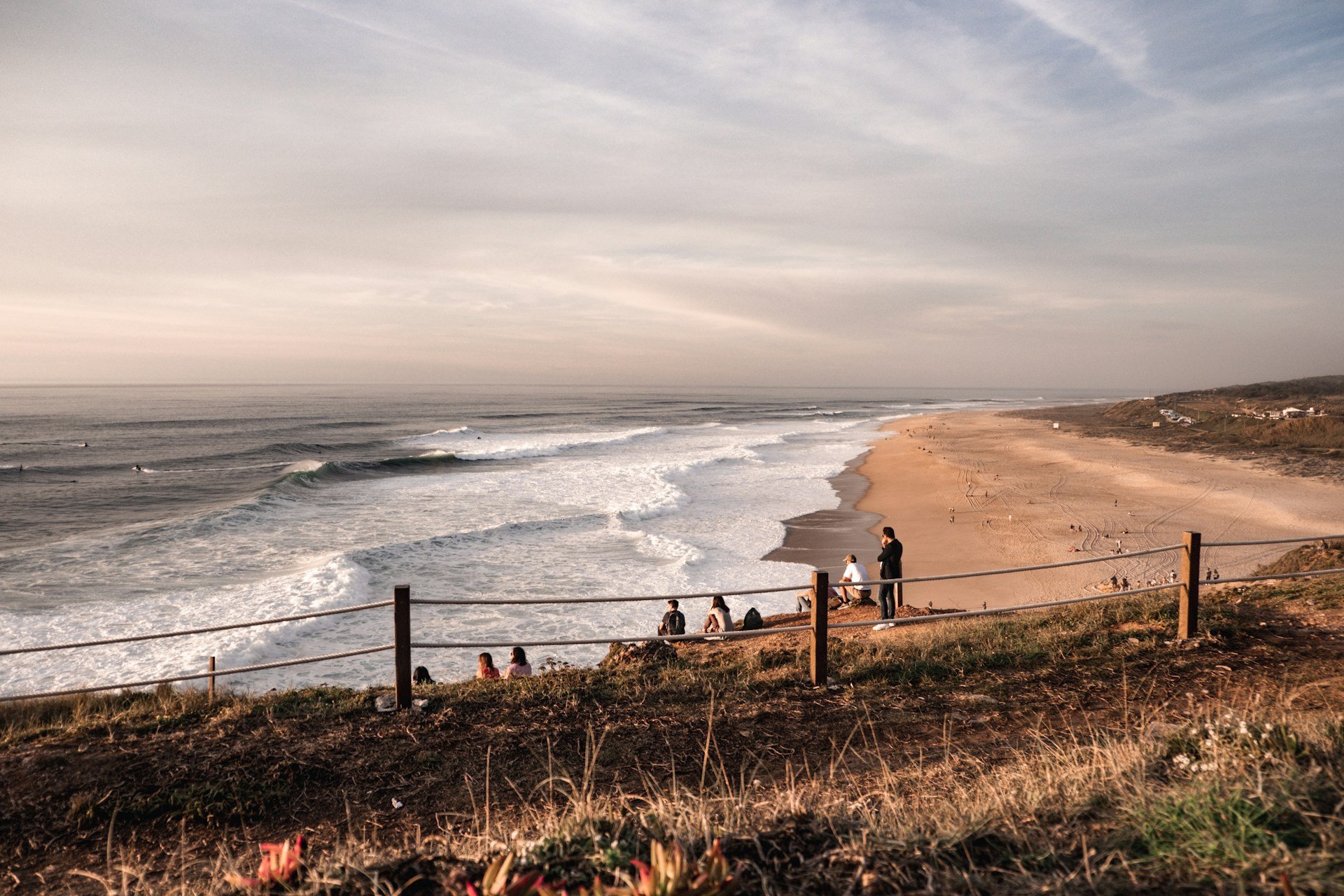
Here are some tips that can help you along the Camino Portugues Coastal Route:
- You can combine the Litoral Way and the official Coastal Route in a way that suits you best.
- Prepare approximately 25-40 EUR per person daily, depending on your accommodation and food choices.
- You can use apps like Buen Camino or Wise Pilgrim on your trip.
- You can use backpack delivery services – they are way more developed on the route from Porto to Santiago de Compostela than from Lisbon to Porto – to deliver your backpack to your next accommodation.
- The stops we’ve shared are just recommendations. You can stay in different cities and split the stops depending on your hiking/walking experience.
Camino Portugues – The Central Route
Now that we’ve covered all the stops on the Coastal Route, let’s move to the Central Route. Although it was once preferred by most pilgrims, it is now slightly overshadowed by the Coastal Route.
Nonetheless, the Central Route of the Portuguese Camino is still the best choice for those interested in historical or cultural landmarks. In addition, it’s best to take the Central Route if you’re walking the Camino Portugues in, let’s say, April or October. You certainly don’t want to get trapped on a beach during a rainstorm.
The Central Route differs from the Coastal Route up until reaching Redondela. From Redondela to Santiago de Compostela, it’s the same route. Therefore, we’ll only outline the first half of the journey.
The Central Route – Porto to Redondela
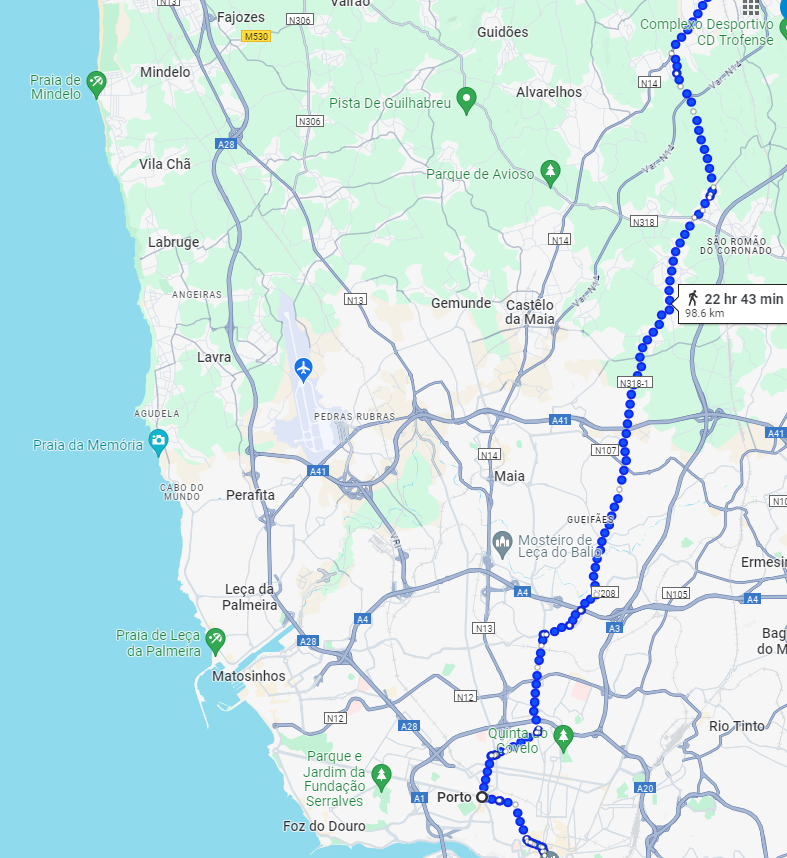
- Porto -> Vilarinho das Cambas = 18 miles (29 km)
- It’s quite a long walk but easy nonetheless. It takes you through various residential areas, forests, and small towns.
- Vilarinho has a private albergue where you can stay.
- If today’s trip is too long, you can stop in Trofa and continue your journey the next day.
- Vilarinho -> Barcelos = 13.7 miles (22 km)
- The first half of today’s walk is mostly through towns. The second half, however, changes the view completely as it takes you through a large forest. Once you reach Barcelos, you can check its historical center – a pleasant reward for such a long trip!
- There’s an albergue in Barcelos, so you can check if they have any available rooms.
- Barcelos -> Aborim = 7.5 miles (12 km)
- On your way to Aborim, you’ll walk through forests and fields. There are also several restaurants and bakeries along the way.
- Check out the Casa de Santiago Albergue in Aborim.
- If the trip is too short, you can continue to Ponte de Lima – it will amount to 34 km.
- Alternatively, you can walk from Barcelos to Vitorino dos Piães (13.6 mi or 22 km) and from there, to Ponte de Lima (7.5 mi or 12 km).
- Aborim -> Ponte de Lima = 13.6 miles (22 km)
- Ponte de Lima is a charming city – one of the most popular on the Portuguese Way.
- There are plenty of hotels in Ponte de Lima where you can stay.
- Ponte de Lima -> Rubiães = 11 miles (18 km)
- This part can be quite tiring because there aren’t too many cafes and shops on the way to Rubiães, so you’ll have to pack water and snacks beforehand.
- Rubiães has a municipal albergue, so you’re covered if you manage to find a room.
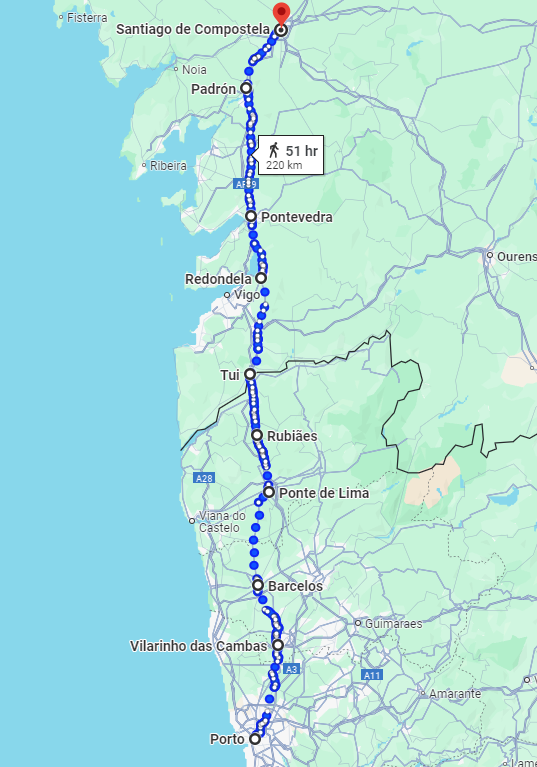
- Rubiães -> Tui = 12 miles (19 km)
- It’s time to cross the border to Spain – in other words, we’re getting nearer and nearer to our destination!
- Make sure to stop by the Valença Fortress!
- Once in Tui, you can check in at a public albergue if it has any available rooms.
- Tui -> Porriño = 9.3 miles (15 km)
- The road from Tui to Porriño can be rather crowded – the thing is that many pilgrims walk only from Tui to Santiago de Compostela, as it’s the minimum required distance to get the Compostela certificate.
- There are several private albergues in Porriño.
- Porriño -> Redondela = 10 miles (16 km)
- From Porriño, you’ll head to Veigadaña and the beautiful town of Mos. From there, you’ll walk through a forest to reach Redondela.
- In Redondela, you can stay at the Public Albergue de Redondela.
From Redondela, head to the stops we’ve mentioned above (see the Coastal Route heading: Pontevedra, Caldas de Reis, Padron, and Santiago de Compostela).
The Spiritual Way – Camino Portugues
There’s another route you can take once you’re in Pontevedra – the Spiritual Variant. You’ll have to walk 50 miles (74 km) on foot and cross 17.4 miles (28 km) by boat. It is believed that the remains of Santiago reached the Iberian Peninsula through this route, which is why some pilgrims choose it.
It’s worth noting that the Spiritual Variant is a bit longer than the Central Route but totally worth it thanks to the spiritual enrichment and the picturesque setting!
In short, here’s how the Spiritual Variant differs from the Central Route:
- Pontevedra -> A Armenteira = 13 miles (21 km)
- Armenteira -> Vilanova de Arousa = 11 miles (18 km)
- Vilanova de Arousa -> Padron = 18.7 miles (30 km), of which most are on the pilgrims’ boat
From Padron, you’ll continue your journey to Santiago de Compostela like other pilgrims.
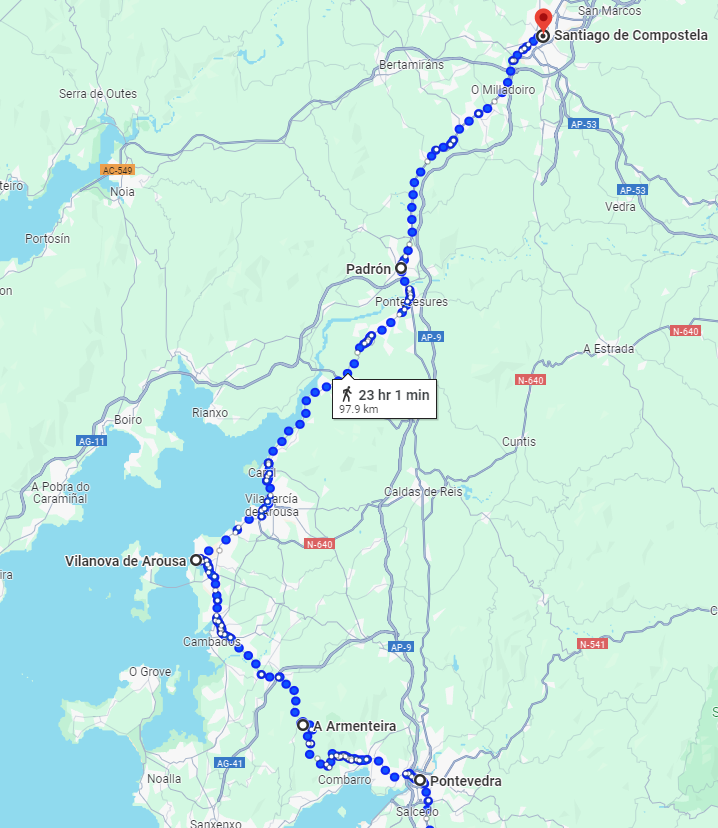
About the Credencial and the Stamps
Let’s not forget about the Credencial or the so-called Pilgrim’s Passport. Without it, you won’t be able to stay at the albergues or pilgrim’s hostels. Without it, you won’t receive the Compostela certificate either, so take great care of it!
In order to get the Compostela certificate, you have to walk at least 100 km. You’ll have to collect at least two stamps daily for your Credencial. You can stop at churches or town halls for the stamps. Once you reach your destination, you’ll have to show your Credencial to apply for the Camino Compostela certificate.
Frequently Asked Questions
What is the best time of year to walk the Portuguese Camino?
The best time of the year to walk the Portuguese Camino is May, June, and September. The weather is best during those months. By contrast, April and October are quite rainy, July and August are extremely hot. The months between November and April are cold, rainy, and windy, and many albergues are closed.
How long does it take to walk the Portuguese Way?
It takes approximately 25 – 30 days to walk the Portuguese Way from Lisbon and 12 – 15 days to walk the Portuguese Way from Porto. It takes 5 – 7 days to walk the Portuguese Way from Tui.
Is the Portuguese Camino Difficult?
Without a doubt, the Portuguese Camino isn’t for beginners. It requires preparation and training because, ultimately, you’ll walk approximately 25 km a day for 15 – 30 days depending on the chosen route. If you’re an experienced hiker, this route isn’t challenging at all – besides the fact that it’s hilly here and there, the route is quite easy. You may also want to consider that Portugal has many stone-paved roads, so you’ll need suitable shoes.
Where does the Portuguese Way start?
You can start the Portuguese Way either in Lisbon or Porto. Some pilgrims prefer to start their journey to Santiago de Compostela in Tui.
Which Camino is best in Portugal?
You can choose one of the several routes of the Portuguese Camino. First, you can start in Lisbon, head to Porto, and then to Santiago de Compostela. Secondly, you can begin your Portuguese Camino de Santiago in Porto and choose one of the three routes: the Litoral Way, the Coastal Route, or the Central Route. You can also start your journey in Tui and walk 100 km to Santiago de Compostela. The most popular routes in Portugal are the Coastal and the Central Routes. However, there is no best route – just pick the one that suits your preferences and hiking experience.
What is the difference between the coastal and central Portuguese Camino?
The coastal Portuguese Camino is closer to the shore, while the central Portuguese Camino takes you through inland Portugal. Ultimately, your choice should depend on your preferences and hiking experience. It’s also worth noting that although the Coastal Way is usually less crowded than the Central Route, it has become incredibly popular in recent years, so you may still “share your journey” with many other pilgrims. In addition, don’t forget about the weather – if you walk the Portuguese Camino in April or October, you should prepare for strong winds and rainstorms.
What is the most scenic part of the Portuguese Camino?
The Litoral Way (Porto – Redondela) is the most scenic part of the Portuguese Camino.

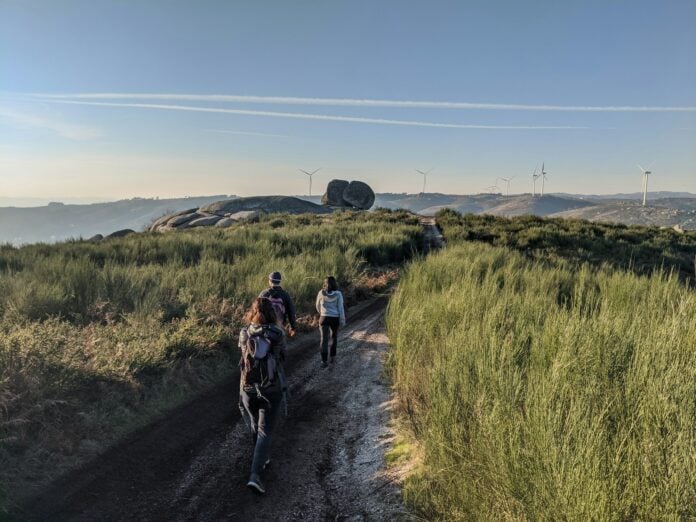

I am wanting to cycle the Camino from Porto to Santiago de Compostela in September 2025 .
Is it t possible to cycle the same route as walkers?
Thinking of doing the costal camino .
Dear Susan, what a great adventure! Yes, you can cycle the same route as walkers and the coastal camino would be a great option.